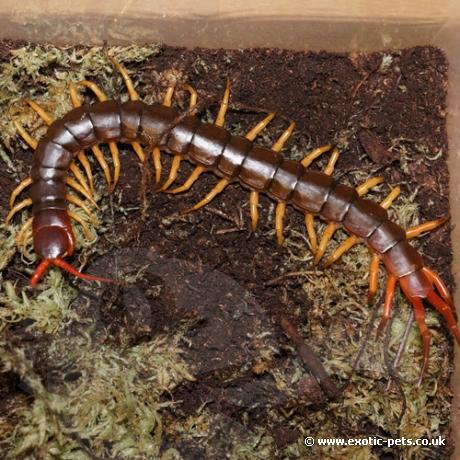

Scolopendra dehaani is an aggressive species that grows to an adult size of 7 to 8 inches. We do not recommend this species for beginners.
The Vietnam Giant Centipede is an impressive creature, they are large, growing up to and occasionally above 8 inches long. Their body colour is a orange/brown with dark colouring on the end of each segment. The colouration of the head and legs can be a light to rusty orange.
They are very fast and rather vicious and so will bite, their venom is medically significant. Although this doesn't mean a bite will require medical attention it is very painful and some react quite badly to it with the pain shooting right up their arm if they are bit on the hand. Because of this great care must be taken when moving the creature into its enclosure and it should never be handled.
Although the name suggests they are only found in Vietnam this is not the case. They can be found throughout tropical and sub-tropical regions, however they are mainly found in Southern Asia.
They should be kept in a glass tank or roomy plastic enclosure, even a big clear storage tub will do. Make sure it is at least double the length of the centipede and as least as wide as it. They do not require height although it is advised to make it taller then the centipede is long so it cannot press itself against the corners and stand on it's back legs, then escape. They can't actually climb up smooth surfaces though so as long as the enclosure is over 8 inches tall it should be secure.
The substrate should be something like organic potting soil, make sure it is free from fertilizers or pesticides, or coco fibre which you can buy in expandable bricks. This should be about 5 inches or so deep, they do like to burrow sometimes.
Décor wise not much is needed in the tank. Provide something for it to hide under like a piece of cork bark or a plant pot on its side half buried in the substrate. Adding a layer of leave litter can also help achieve this.
Room temperature should be perfectly suitable but if your house is rather cold (below 20C/65F night and day) a heat mat on the side of the tank should be used to help raise temperatures to 22-24C (71-75F), make sure it doesn't get too warm. At higher temperatures such as 30C (86F) their metabolism will increase which will mean although they may eat more, they will have a shorter life span.
Humidity wise they like it at about 80%. To achieve this you should keep them in a glass or plastic tank with some ventilation but not too much as to let all the moisture escape, also make sure any ventilation holes you make into the sides of plastic tanks are not big enough for the centipede to escape through. You should provide a small shallow water bowl and mist the substrate well once every two days.
Food wise any commercially available live food such as crickets, locusts and mealworms will be gladly accepted, just make sure the prey is of a manageable size. They can tackle surprisingly large food as adults, adult locusts and crickets are the most advised.